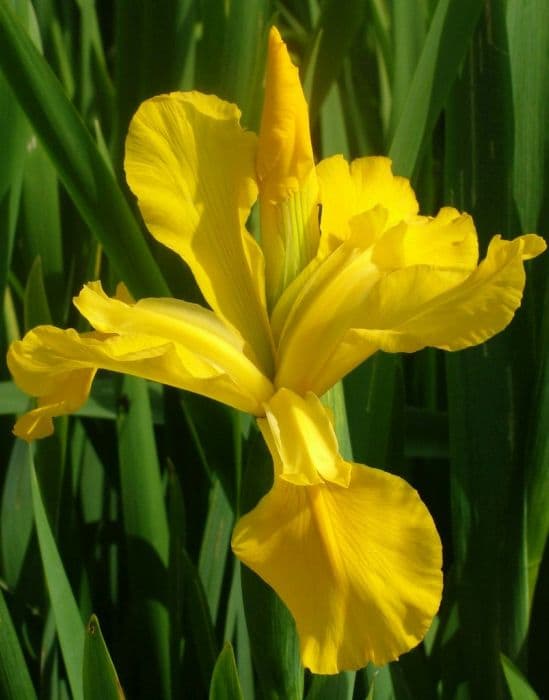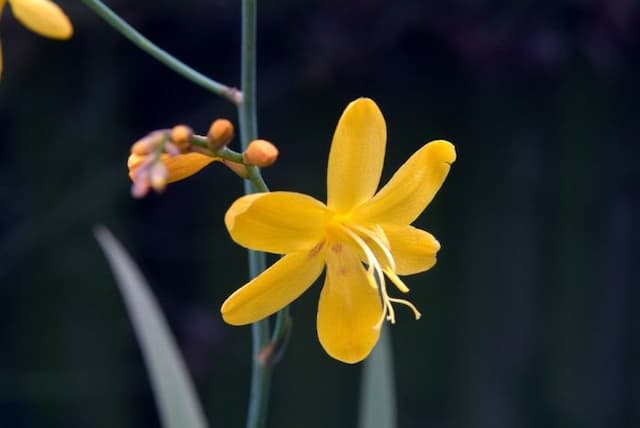Spuria Iris Iris 'Hickory Leaves' (Spuria)

ABOUT
Iris 'Hickory Leaves' is a striking plant with a distinctive appearance typical of the Iris family. The flowers of this Iris are particularly beautiful, with large, showy petals that can come in a range of colors from deep purples and blues to yellows and whites. Each bloom has six lobes; three of them stand upright and are known as 'standards,' while the other three hang down, called 'falls,' often showcasing a lovely contrast of color or pattern with veining or speckles. The falls may have a soft beard or crest on them that can be a different shade from the rest of the petal, which provides a dramatic visual interest. The foliage of the 'Hickory Leaves' Iris is also noteworthy. The leaves are typically long and sword-shaped, forming an attractive, dense clump. The leaves have a lush, green color that complements the vibrant hues of the blossoms. As the plant name suggests, the leaves may sometimes mimic the texture or coloration reminiscent of hickory leaves, adding to the unique aesthetic of this Iris variety. The plant overall has a robust and upright posture, with the flowers held aloft on sturdy stems, making them an excellent addition to gardens for their ornamental value. This particular Iris variety blooms typically in the late spring to early summer, depending on the climate. It contributes to garden landscapes with its striking blooms and architectural leaf structure, making it a popular choice among gardeners who wish to add vertical interest and a touch of elegance to their floral displays.
About this plant
 Names
NamesFamily
Iridaceae
Synonyms
Hickory Leaves Spuria Iris
Common names
Iris 'Hickory Leaves'
 Toxicity
ToxicityTo humans
The Spuria Iris, including the 'Hickory Leaves' cultivar, contains compounds that can be toxic if ingested. These plants have a substance, particularly in the rhizomes (rootstocks), that can cause irritation to the skin and the digestive tract. If parts of the plant are consumed, the person might experience symptoms such as nausea, vomiting, abdominal pain, and diarrhea. In some cases, skin contact with the sap can lead to irritation or dermatitis. It is advisable to handle these plants with care and ensure that they are not ingested to avoid these toxic effects.
To pets
The Spuria Iris 'Hickory Leaves' is considered toxic to pets if ingested. It contains irisin, iridin, or irisine which can cause gastrointestinal issues in animals. If a pet consumes parts of the Spuria Iris, especially the rhizomes, they may exhibit symptoms such as salivation, vomiting, diarrhea, lethargy, and abdominal pain. It is important to prevent pets from chewing on or ingesting this plant to avoid these adverse health effects.
 Characteristics
CharacteristicsLife cycle
Perennials
Foliage type
Deciduous
Color of leaves
Green
Flower color
Yellow
Height
3-4 feet (0.91-1.22 meters)
Spread
2-3 feet (0.61-0.91 meters)
Plant type
Herb
Hardiness zones
4
Native area
Europe
Benefits
 General Benefits
General Benefits- Ornamental Value: Iris 'Hickory Leaves' adds visual interest to gardens with its striking color and tall, elegant blooms.
- Ease of Care: This plant is relatively low-maintenance, requiring minimal care once established in suitable conditions.
- Drought Tolerance: It is quite resistant to drought, making it suitable for xeriscaping or gardens in arid climates.
- Attracts Pollinators: The flowers attract bees, butterflies, and other pollinators, helping to support local ecosystems.
- Versatility: It can be used in a variety of landscape settings including borders, waterside plantings, and as cut flowers.
- Seasonal Interest: Iris 'Hickory Leaves' has a specific blooming season that can be coordinated with other plants for a succession of color.
- Deer Resistance: It is generally resistant to deer, which can be particularly beneficial in areas where deer browsing is a common issue.
- Soil Adaptability: This plant can adapt to various soil types, although it prefers well-draining soil.
 Medical Properties
Medical PropertiesThis plant is not used for medical purposes.
 Air-purifying Qualities
Air-purifying QualitiesThis plant is not specifically known for air purifying qualities.
 Other Uses
Other Uses- Biological Pond Filtration: The robust root system of Iris Spuria can be used in constructed wetlands or pond filters to help remove excess nutrients and pollutants from water.
- Natural Dye: The flowers and leaves of the Spuria Iris may be used to produce natural dyes for textiles, providing a range of colors from greens to yellows depending on the mordant used.
- Educational Tool: The Spuria Iris can be grown in school gardens as a way to teach children about plant biology, lifecycles, and the importance of biodiversity.
- Erosion Control: These plants, with their extensive root systems, can be planted on slopes or areas prone to erosion to help stabilize the soil and prevent soil loss.
- Artistic Inspiration: Artists can use the intricate patterns and colors of the Spuria Iris as a subject for paintings, sketches, and even as inspiration for fashion designs.
- Culinary Garnish: While not widely known for their edibility, the petals of some Spuria Iris can be used as a decorative, non-toxic garnish for salads and desserts.
- Photography Subject: The unique beauty of the Spuria Iris, especially during its blooming season, makes it a popular subject for garden and nature photographers.
- Garden Design: Used in xeriscaping, Spuria Irises are ideal for dry garden designs due to their tolerance of drought conditions once established.
- Companion Planting: Iris Spuria can be strategically planted to accompany other plants in the garden, attracting pollinators and potentially deterring certain pests.
- Floral Arrangements: The tall and elegant stalks adorned with colorful blooms make the Spuria Iris a valuable addition to fresh cut floral arrangements.
Interesting Facts
 Feng Shui
Feng ShuiThe Iris is not used in Feng Shui practice.
 Zodiac Sign Compitability
Zodiac Sign CompitabilityThe Iris is not used in astrology practice.
 Plant Symbolism
Plant Symbolism- Hope - The iris often symbolizes hope, reflective of the flower's ability to bring joy with its beauty and herald the spring season after a long winter.
- Trust - With its intricate design and upright petals, the iris conveys a message of trust, indicating steadfastness and reliability in the language of flowers.
- Wisdom - Historically associated with the Greek goddess Iris, who linked the gods to humanity, the iris represents wisdom and valued knowledge.
- Purity - The iris's bright colors and delicate patterns are often associated with purity, conveying a sense of innocence and cleanliness.
- Courage - The robust nature of the iris, able to bloom in a variety of conditions, signifies courage and the valor to face life's challenges.
- Royalty - Often found in royal emblems and crests, the iris symbolizes royalty, nobility, and lofty ideals, possibly due to its regal appearance and association with ruling class aesthetics.
- Good News - As the flower of the Greek goddess Iris, the messenger of the gods, the bloom is often taken as a symbol of good news or tidings.
 Water
WaterSpuria Iris requires consistent moisture, especially during the growing season. Water the plant once a week with about 1 to 1.5 gallons of water, ensuring that the soil is kept moist but not waterlogged. During the hotter months, you might need to water twice a week if the soil dries out faster. Reduce watering in the winter months when the plant is dormant. Always check the soil moisture before watering to avoid overwatering, as this can lead to root rot.
 Light
LightSpuria Iris thrives in full sun to partial shade. The ideal spot for these irises is where they can receive at least 6 hours of direct sunlight each day. A location that offers morning sunlight and afternoon shade can be beneficial in regions with very hot summers, as it prevents the leaves from scorching.
 Temperature
TemperatureSpuria Iris plants are quite adaptable and can withstand temperatures as low as 0°F (-18°C). They grow best in a temperature range of 55°F to 75°F (13°C to 24°C). They can survive in warmer conditions up to 90°F (32°C), but it's crucial to provide extra water in these higher temperature ranges to prevent stress on the plant.
 Pruning
PruningSpuria Iris should be pruned to remove spent flower stalks after blooming to encourage a tidy appearance and prevent energy from being wasted on seed production. Additionally, prune away any dead or damaged leaves in the spring or fall. This helps prevent disease and encourages healthy growth. The best time to prune is immediately after flowering, and again as the foliage begins to die back in late fall.
 Cleaning
CleaningAs needed
 Soil
SoilThe Spuria Iris, commonly known as Spuria, thrives in a well-draining loamy soil with a neutral to slightly acidic pH between 6.0 and 7.0. A mix composed of garden loam, compost, and some coarse sand or perlite can provide the ideal conditions for healthy root growth and adequate drainage which is essential for the Spuria.
 Repotting
RepottingSpuria Irises typically do not require frequent repotting. It is best to repot or divide these plants every three to five years to prevent overcrowding and maintain plant vigor. Dividing should be done after blooming, typically in late summer.
 Humidity & Misting
Humidity & MistingThe Spuria Iris prefers moderate ambient humidity but is quite adaptable and does not require specific humidity levels unlike some tropical plants. Ensuring good air circulation around the plants can help prevent issues related to humidity.
 Suitable locations
Suitable locationsIndoor
Place Spurias near a window with bright, indirect light.
Outdoor
Plant Spurias in full sun to partial shade in well-draining soil.
Hardiness zone
4-9 USDA
 Life cycle
Life cycleIris 'Hickory Leaves' begins its life cycle when the seeds are sown, typically in late summer or fall, where they germinate to produce small sprouts. These seedlings develop into larger plants with characteristic grass-like leaves, which establish themselves over the winter. In the spring, the plant enters a rapid growth phase, with the leaves lengthening and the floral stems, or scapes, emerging from the base of the plant. Flowering occurs in late spring to early summer, showcasing the distinct yellow or blue blooms common to Spuria Iris, after which the flowers are pollinated. Following pollination, seed pods develop, mature over the summer, and finally release seeds, continuing the reproductive cycle. After blooming, the plant enters into a period of dormancy, especially in regions with hot summers, conserving energy to repeat the cycle in the following year.
 Propogation
PropogationPropogation time
Early Spring
Propogation: The Iris 'Hickory Leaves', a type of Spuria iris, is commonly propagated through division, which is best done from mid-summer to early fall. To propagate by division, carefully dig up the rhizomes after the flowering period when the plant is dormant. Using a sharp knife, divide the rhizomes so that each piece has at least one fan of leaves and a section of the roots. Trim the leaves to about one-third of their original length to reduce water loss and replant the divisions at least 12 inches (about 30 centimeters) apart and 1 to 2 inches (2.5 to 5 centimeters) deep in well-drained soil with good sun exposure. Water the newly planted rhizomes well to help establish them. This method allows for the spread of the Spuria iris while also rejuvenating the parent plant for more vigorous growth in the following seasons.









